Covering a staggering 30.5 million acres of Oregon‘s land, forests proudly represent almost an entire half of the state’s territory. As you might be able to imagine, a thriving biodiversity awaits here. There is an impressive collection of tree species that are native to the area. From towering conifers of 30 native distinct species to a variety of 37 different native broadleaf trees, these giants stand as a testament to Oregon’s rich and pristine natural habitat. This green oasis invites one to witness nature in its purest and most captivating form. In this article, we’ll go over the 10 most iconic trees native to Oregon and get to know them.

What Trees Are Native to Oregon?
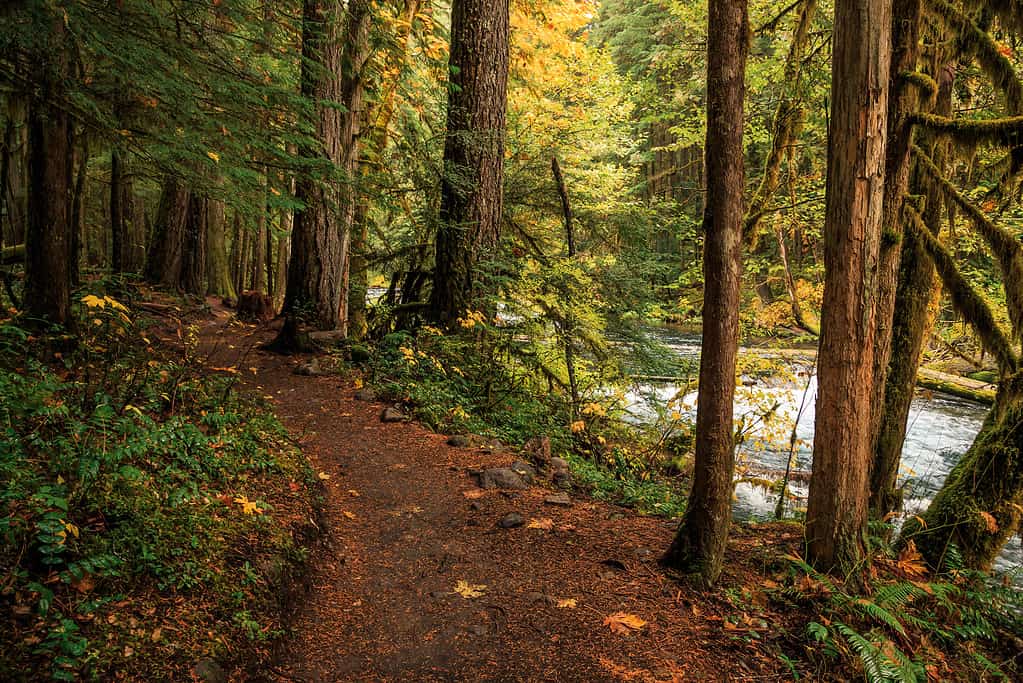
Boasting a variety of different trees, Oregon is one of the most forest-dense states in the country.
©Bartfett/iStock via Getty Images
Oregon is a haven for varied plant life. The state showcases numerous trees that dot its diverse terrains, ranging from the coastal areas to the peaks of the Cascade Range, extending to the dry regions of eastern Oregon. The state experiences a wide range of climates, influenced by differences in altitude, temperatures, wind patterns, rainfall, and soil types. These varying elements play a significant role in establishing the predominant tree varieties in different regions. In fact, Oregon has a reputation as one of the most forest-dense states in the nation.
The Douglas fir, symbolic of the Pacific Northwest, holds the title of Oregon’s official state tree. It stands as a majestic representation of the region’s lush greenery.
The western hemlock thrives as another iconic tree representative of the Pacific Northwest, even earning the distinction of Washington’s state tree.
In the western part of Oregon, specifically in the Willamette Valley, the Oregon white oak flourishes. Beyond its status as a native tree, it serves as a vital resource for timber. This tree offers sturdy and dense wood that finds use in crafting furniture and laying flooring.
The bigleaf maple marks the sole maple variety in Oregon with commercial significance.
Going into the lush landscapes within the state, you can also encounter the Sitka spruce. Apart from gracing the region with its presence, it serves as a vital habitat and food source for wildlife. In particular, it offers food to deer and elk, especially in the chilly winter season.
1. Grand Fir (Abies grandis)
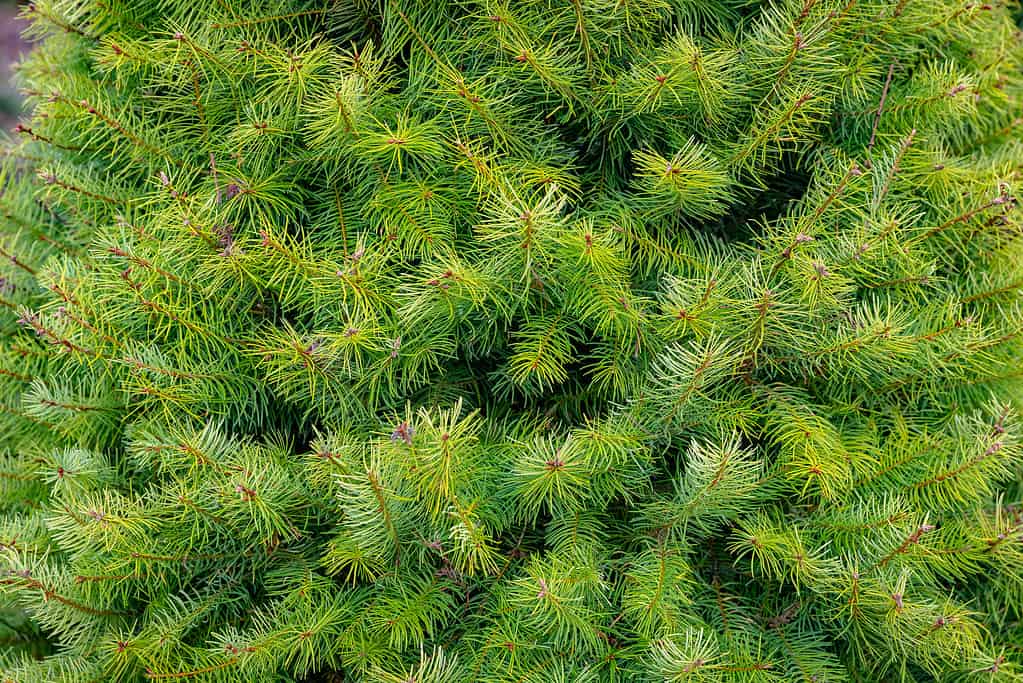
The grand fir is one of the tallest firs in the world, reaching up to 250 feet tall.
©Gerardo Martinez Cons/iStock via Getty Images
Found mostly in the western parts of Oregon, including river valley areas and the lower portions of the western Cascades up to 3,000 feet, the grand fir is a sight to behold.
Recognized as one of the tallest firs in the world, this towering evergreen tree has an initially narrow and conical shape. As it matures, the grand fir gradually becomes more rounded. The branches of this tree, which splay out and droop slightly, are covered with needles. These needles are pointed and glossy dark green on the top, featuring dual silver streaks on the underside. Organized in two neat, flat rows, they release a pleasant citrusy or orangey scent when broken.
Growing rapidly, the grand fir’s bark is initially gray in color and smooth. But over time, it transforms into a thicker and browner texture. Serving as an impressive centerpiece in any landscape, this tree can achieve heights between 100 and 250 feet, with a width spanning 20 to 35 feet. The grand fir is native to areas like the northern Rocky Mountains and eastern Oregon.
The grand fir tree thrives when planted in locations that receive ample sunlight or partial shade. It prefers nutrient-rich, slightly acidic soil that retains moisture well yet also offers good drainage.
2. Bigleaf Maple (Acer macrophyllum)

A deciduous tree, the bigleaf maple grows in southwestern Oregon.
©Min C. Chiu/Shutterstock.com
The bigleaf maple thrives in hot, dry regions and even flourishes in the harsh and arid regions of southwestern Oregon.
Well-loved along the Pacific Coast, the bigleaf maple is a prominent deciduous tree that grows upright and sports a vast, rounded canopy formed by substantial, outward-spreading branches that angle sharply at the ends. In the springtime, the leaves, which are notably the largest among maple species, burst forth in a rich burgundy color. They’re certainly a sight to behold! These expansive leaves transition from a lush dark green in summer to hues of orange and yellow when fall arrives. Around spring, the tree also displays small, aromatic, yellow-green blossoms that hang in clusters. They measure between 4 and 8 inches in length.
Adorning landscapes with their furrowed bark that ranges from gray to a reddish-brown shade, the bigleaf maple serves as a splendid shade tree in Oregon. It is especially a showstopper in the fall. This swift-growing tree also plays a vital role in the ecosystem, providing food and shelter for various wildlife throughout its lifetime, living up to 200 years.
Standing proudly at heights and widths between 40 and 70 feet, it makes a magnificent addition to expansive gardens and park areas. For optimal growth, it prefers spots with ample sunlight or partial shade and thrives in moist, well-draining soil conditions.
3. White Alder (Alnus rhombifolia)

White alders are a great food source for various animals, including caterpillars.
©Wirestock Creators/Shutterstock.com
In Oregon, white alders are commonly found near streams or situated on the drier, rocky slopes just above them. These trees occupy a huge range in terms of elevation, from just above sea level to 7800 feet.
This rapidly growing medium-sized deciduous tree is known for its elegant structure. It boasts a pyramidal crown in its early stages, which gradually transforms into a more oval shape as it ages. With a straight trunk supporting its lean, outward-reaching branches that tend to sag at the ends, it paints a graceful picture in any landscape.
The young white alder trees have a smooth, ash-gray bark that becomes increasingly scaly as they mature. Their leaves, which are broadly shaped and finely edged, start off with an apple-green color and transition into a dark green hue as they develop.
Adding a touch of charm to its branches are the catkins that later give way to brown, cone-shaped fruits. Serving as a substantial food resource for various wildlife, the white alders host many caterpillar species.
Reaching heights between 50 and 80 feet and spanning a width of 40 to 60 feet, these trees are a prominent feature in the Oregon landscape. They prefer spots that offer plenty of sunlight or partial shade and soils that are moderately fertile and moist.
4. Pacific Madrone (Arbutus menziesii)
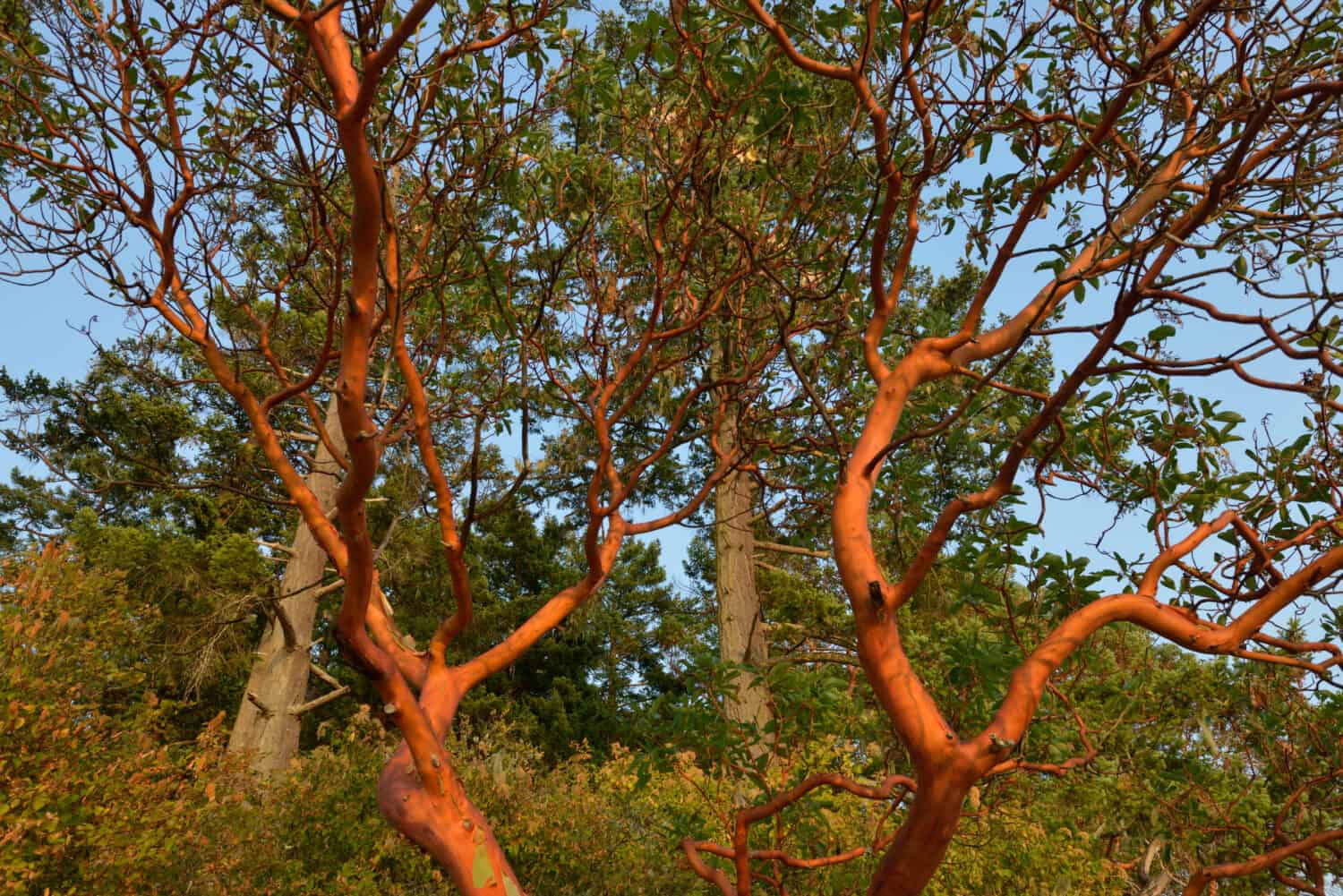
A unique feature of the Pacific madrone is its red-brown bark that peels in flakes.
©Kevin Oke Photo/Shutterstock.com
An evergreen tree, the Pacific madrone graces numerous locations in Oregon, such as roadsides, parks, and forests, offering a unique spectacle with its widespread presence.
This remarkable tree stands out with its expansive branching structure and thick, shiny, dark green leaves that can measure up to 6 inches in length. As spring arrives, the tree adorns itself with cascading groups of white, urn-shaped flowers that dangle gracefully from the branch tips. These flowers, abundant in nectar, act as magnets for hummingbirds, bees, and various other pollinators. In the fall, the Pacific madrone boasts reddish-orange fruits. Adding to its aesthetic appeal is the tree’s reddish-brown bark with a satin-like smoothness, which peels in flakes.
With its gorgeous blossoms, the Pacific madrone is one of the most picturesque broadleaf flowering evergreens you may find.
Reaching heights and widths between 20 and 50 feet, this tree flourishes effortlessly in soils that are moderately fertile, acidic, and well-draining. Ideally, they should be planted in areas receiving full sun to partial shade to ensure optimal growth.
5. Paper Birch (Betula papyrifera)
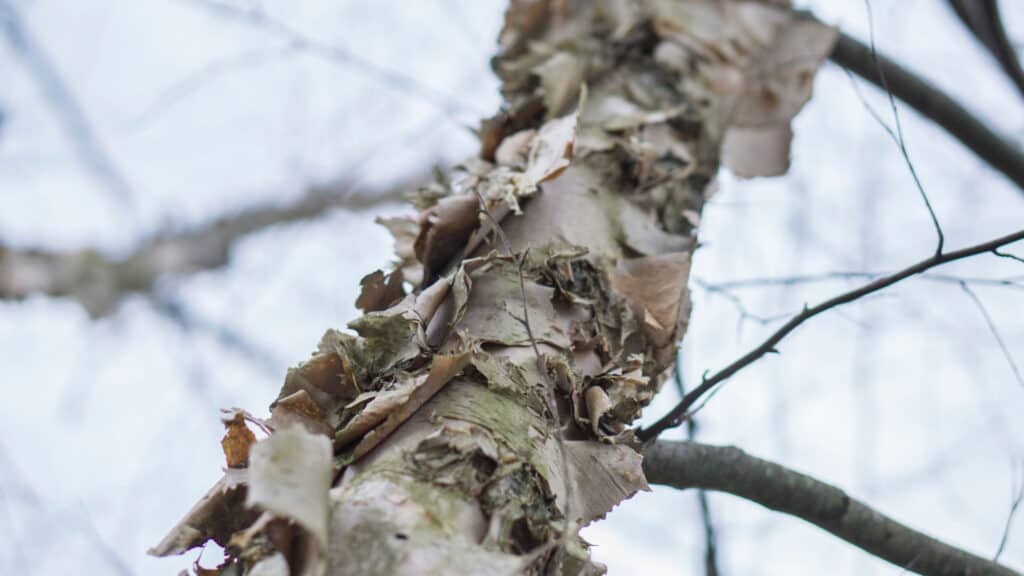
The canoe birch or paper birch is named so due to its bark.
©thematthewhyatt/Shutterstock.com
The paper birch is a prevalent species across North America. In the western region, this birch species is a native tree starting from eastern Oregon.
Also known as the canoe birch, this tree is a popular choice in landscaping due to its rapid growth rate and the stunning visual contrast offered by its bright white bark that sheds in thin, paper-like layers to expose a rich, orange-brown inner bark. As the tree matures, the pristine white bark begins to feature dark, artistic markings. Its leaves, which are dark green in color and oval-shaped, feature uneven serrations along the edges. When fall arrives, these leaves undergo a vibrant transformation to a brilliant yellow hue. The paper birch also boasts yellow-brown male flowers and yellow-green female flowers.
The tree’s name, paper birch, is derived from the characteristic texture of its bark. In the past, people used to peel off sections of the delicate, paper-like bark to write messages on them, utilizing it as a means of communication. The other common name, canoe birch, comes from the Native Americans, who used the bark to make lightweight canoes.
Growing to heights ranging between 50 and 70 feet and spanning a width of 25 to 50 feet, the paper birch thrives both under the full sun or in partially shaded areas. It prefers medium to wet, well-draining soils to flourish.
6. Oregon Ash (Fraxinus latifolia)
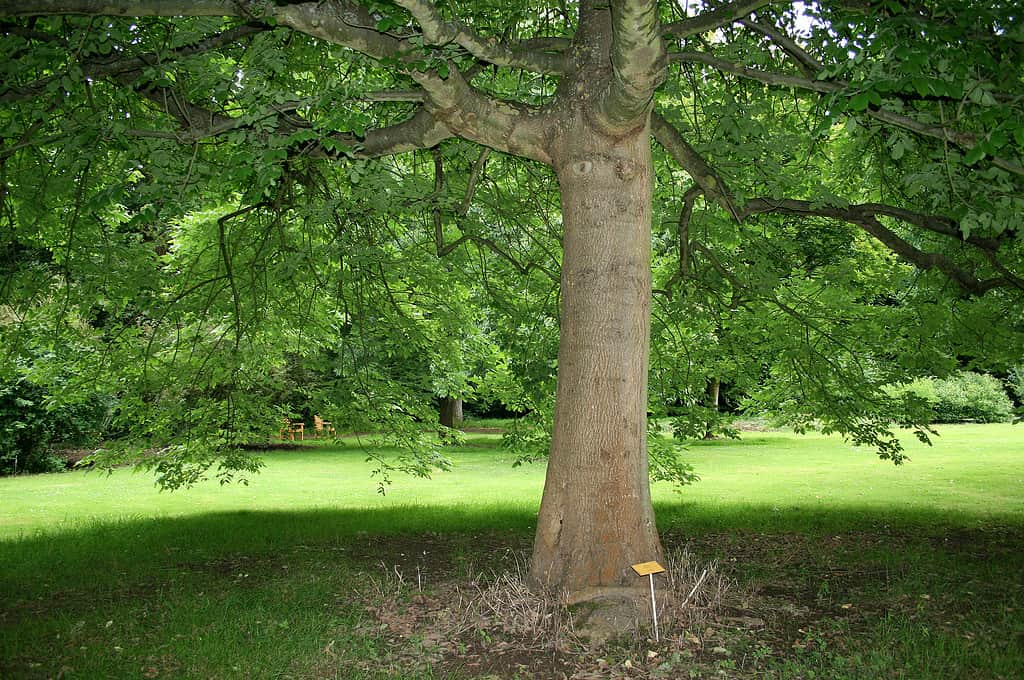
Oregon ash trees can be found in elevations as high as 5000 feet.
In the wetlands of western Oregon, especially in the valleys at lower elevations, the Oregon ash is a prominent feature, often seen lining the banks of streams in mixed forests. However, this tree can be found in elevations as high as 5000 feet.
Native to the western regions of North America, the Oregon ash is a tall deciduous tree. It boasts a straight trunk crowned with a dense yet narrow canopy. Its light green leaves are arranged in groups of 5 to 9 leaflets on a single stem. In the fall, they undergo a transition to a gorgeous yellow hue. While young, the tree has a gray-green, smooth bark that gradually thickens and takes on a gray-brown color, featuring deep furrows as it ages.
This tree is not only a superb provider of shade but also serves as a standout feature in expansive landscapes due to its symmetrical structure, fast growth rate, and robust nature. Over the years, it has become a popular choice as an ornamental tree in Oregon. It is frequently seen gracing streets and adding beauty to the surroundings.
Growing to towering heights of between 60 and 80 feet and spreading out to around 50 feet in width, this tree thrives in locations with full sun to partial shade. For optimal growth, plant it in soils rich in organic matter and are moist to wet.
7. Sitka Spruce (Picea sitchensis)
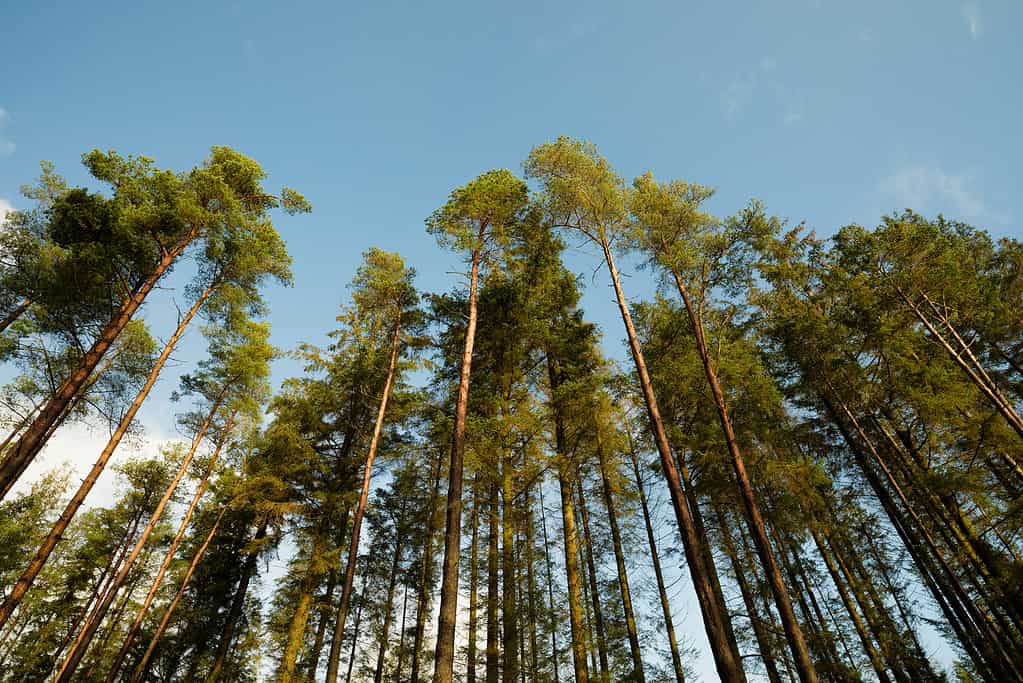
Living up to 800 years, Sitka spruces are tolerant to both wind and salt.
©Graeme J. Baty/iStock via Getty Images
The Sitka spruce mainly thrives at lower altitudes, specifically below 1500 feet in Oregon. Although they start growing slowly, they eventually become some of the fastest-growing trees in the world. Interestingly, these iconic trees of Oregon can live up to 800 years!
Identified as the largest member of the spruce family, the Sitka spruce is a robust evergreen conifer. It has a wide base that supports a spacious, broadly shaped crown that resembles a cone. The tree’s outward stretching branches have stubby, flat, and somewhat prickly needles that are a vibrant dark green color on the top, contrasting with a softer powder blue on the underside. Initially featuring a smooth, gray outer layer, the bark transforms over time. It later assumes a dark purplish-brown color with the appearance of scaly plates as the tree matures.
A noteworthy trait of this tree is its high tolerance to both windy conditions and salt, making it an unparalleled option for locations prone to such environmental factors. Moreover, it is well-suited for areas with less fertile soil. Its name, Sitka spruce, traces back to its historical connection with an island in Alaska named Baranof, previously referred to as Sitka Island.
Capable of reaching towering heights between 50 and 160 feet and expanding to widths ranging from 20 to 30 feet, this tree thrives when planted in locations receiving abundant sunlight, preferring moist and well-draining soil conditions to flourish.
8. Sugar Pine (Pinus lambertiana)
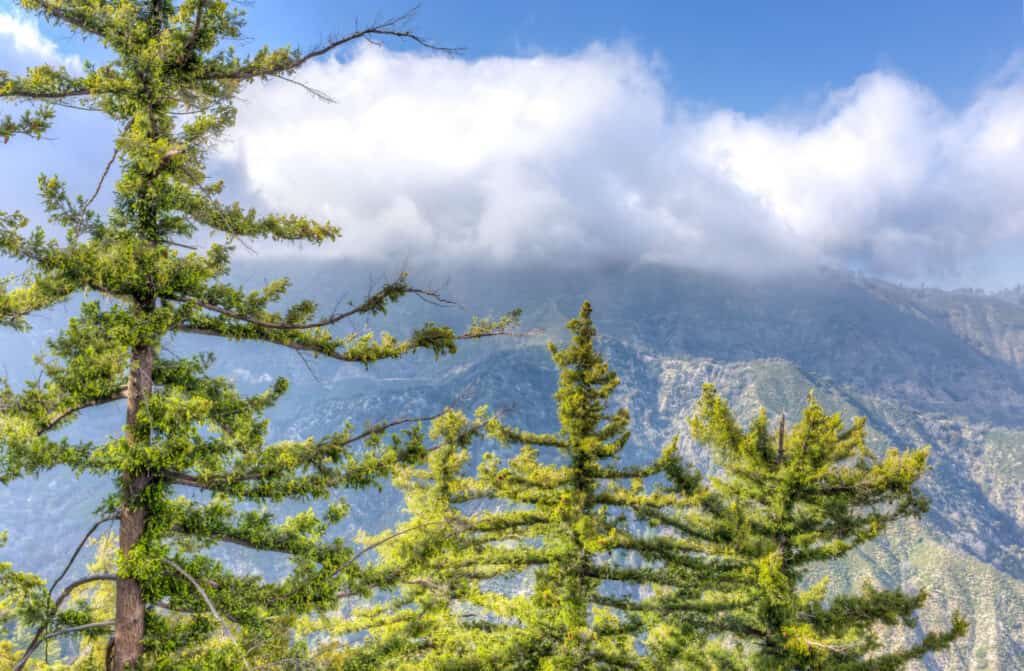
Reaching up to 200 feet tall, sugar pine trees are the tallest and largest pine species.
©Ken Wolter/Shutterstock.com
You can mainly spot the sugar pine trees dotting the landscapes along the border of Oregon and California, particularly throughout the ecologically rich and varied terrain of the Klamath Mountains.
Standing as the largest and tallest pine species, the sugar pine begins its life with a slender pyramid-like structure featuring a long, unbranched trunk and branches that droop slightly. As it ages, the tree transforms, showcasing a broad, flat crown atop its lengthy trunk. Its foliage consists of clusters of five dark blue-green needles, each stretching up to 4 inches in length. What sets this tree apart is its exceptionally long seed cones. They are the longest found in any conifer species, typically measuring between 10 and 20 inches.
The tree’s name, sugar pine, comes from the somewhat sweet resin found in its heartwood. When this part of the tree is cut or burned, it releases the resin, which was a source of food for the local indigenous peoples. Notably, the sugar pine can live up to 500 years!
Growing to impressive heights of between 100 and 200 feet and spreading to about 50 feet in width, this tree thrives in sun-drenched areas with soil that allows for proper drainage.
9. Coast Redwood (Sequoia sempervirens)
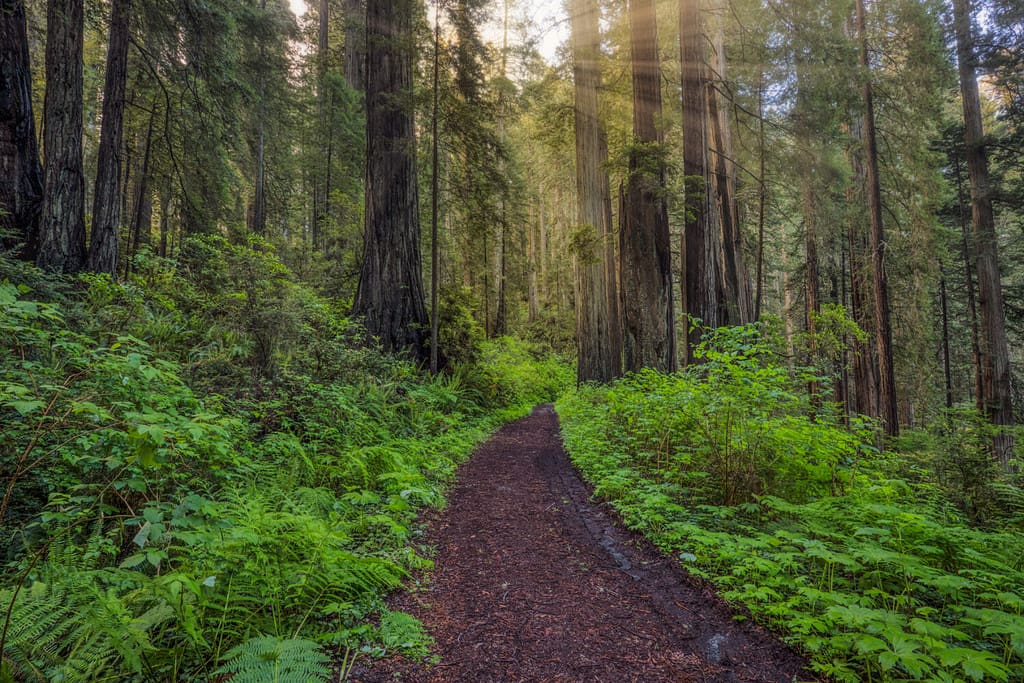
Another iconic native tree in Oregon is the redwood.
©Danita Delimont/Shutterstock.com
In a small region of Oregon, not far from the border with California, you can find redwoods flourishing. Although these redwoods may not be as huge as the ones in California, they are still a sight to behold.
Holding the title of the world’s tallest tree, the coast redwood stands as a vigorous evergreen with a slender yet expansive cone-like structure featuring a robust, broad base and an intricately branched, dense top. Younger trees have a harmonious pyramidal form with branches that either stretch out horizontally or slightly hang down. As they grow, they shed their lower branches, evolving into statuesque figures with elevated crowns. Their bright green, soft needles form delicate clusters along their branches, complemented by deep reddish-brown, textured bark.
Remarkable for its expansive trunk and symmetrical shape, this native of California and Oregon is a true testament to nature’s endurance. They potentially take up to 400 years to fully mature and have the ability to surpass 2000 years of age. Yes, 2000!
The tree can achieve heights ranging between 60 and 100 feet, with a spread of 15 to 25 feet. However, in untamed environments, it can soar to heights exceeding 350 feet. Recognized as one of the most rapidly growing conifers in the world, it can grow approximately 3 feet each year. It thrives in sunlit areas or spots with mild dappled shade, favoring nutrient-rich, moist, and well-draining soil for optimal growth.
10. Douglas Fir (Pseudotsuga menziesii)
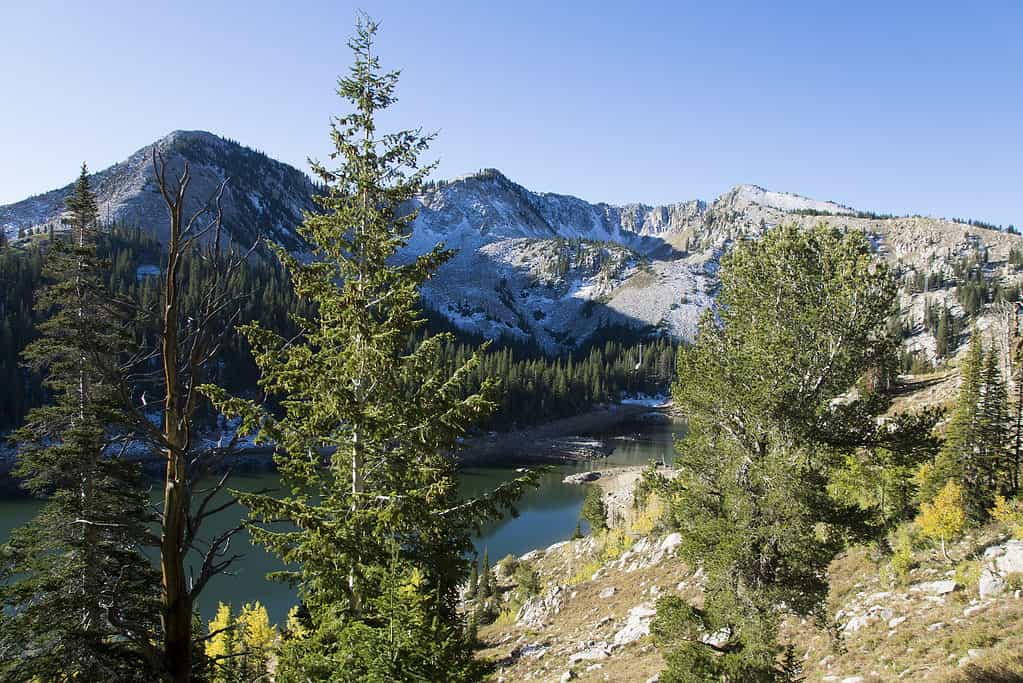
Douglas fir is perhaps the most iconic native tree of Oregon!
©IrinaK/Shutterstock.com
Of course, no list of the most iconic trees native to Oregon is complete without mention of the Douglas fir! The Douglas fir is a symbol of Oregon, gracing numerous state forests, including Clatsop, Santiam, and Elliott, and even making an appearance in the Sun Pass’s southwestern region. The Douglas fir is undoubtedly the most iconic tree in Oregon!
Characterized by its lofty stature and graceful silhouette, the young Douglas fir showcases a pyramid-like structure with lower branches that sag gently and upper limbs that reach skyward. As it matures, it adopts a more uneven conical shape, shedding its lower branches. The needle-like leaves, which can either be deep green or have a bluish tint, are arranged in a spiral pattern and measure around 1.5 inches in length. A distinctive feature is the dual white bands found on the underside of the needles, releasing a pleasant aroma when crushed.
Initially sporting a smooth, gray-brown bark, the tree transforms as it ages, developing a thick, reddish-brown coat with profound grooves. Apart from its natural beauty, it serves a significant role in the timber industry of Western North America and frequently adorns homes across the U.S. during the Christmas season.
This tree, which thrives in both sunny and partially shaded environments, can reach heights between 40 and 80 feet and spread out over an area of 10 to 20 feet. It prefers slightly acidic soil that can retain moisture well yet also offers good drainage.
Summary of the Most Iconic Trees Native to Oregon
| Number | Tree | Average Lifespan |
|---|---|---|
| 1. | Grand Fir | 250 years |
| 2. | Bigleaf Maple | 300 years |
| 3. | White Alder | 100 years |
| 4. | Pacific Madrone | 200 – 250 years |
| 5. | Paper Birch | 80 years |
| 6. | Oregon Ash | 250 years |
| 7. | Sitka Spruce | 700 – 800 years |
| 8. | Sugar Pine | 500 years |
| 9. | Coast Redwood | 800 – 1500 years |
| 10. | Douglas Fir | 1000+ years |
The photo featured at the top of this post is © Kevin Oke Photo/Shutterstock.com
Thank you for reading! Have some feedback for us? Contact the AZ Animals editorial team.







